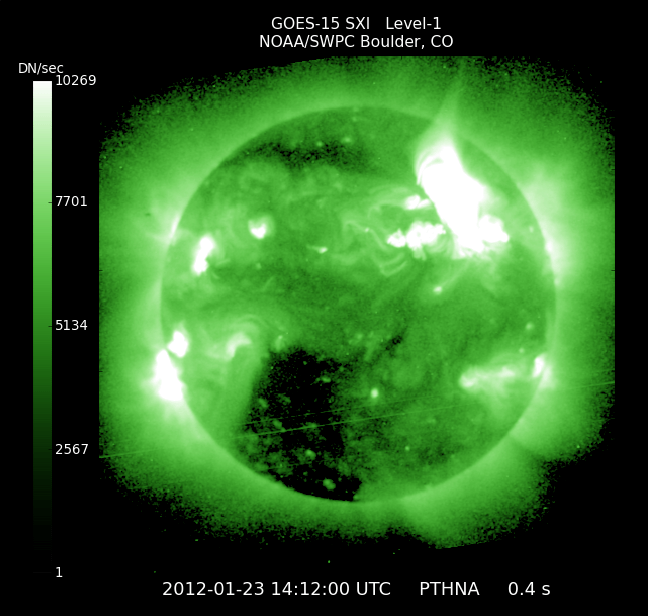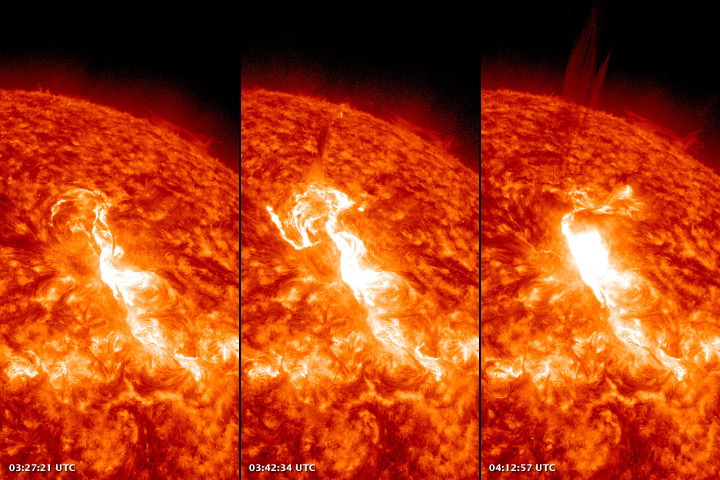Universe Today | Nancy Atkinson | 2012 Jan 23
Earth’s magnetic field is already full of activity from an Earth-directed Coronal Mass Ejection (CME) last week. But all indications are another blast is headed our way from the strongest solar radiation storm since September, 2005. NOAA says the storm is currently in progress and continues to get stronger, with a very fast CME headed towards Earth. Sunspot 1402 erupted, producing a long-duration M9-class solar flare. “Geomagnetic storming is a near certainty from this event,” reported NOAA. The associated solar flare peaked at about 0400 UTC on January 23 (11pm Jan 22 EST).”Click to play embedded YouTube video.
A computer model just released by NOAA’s Space Weather Prediction Center forecasts the storm will arrive sometime on January 24, at about 14:18 UT (+/- 7 hours), as the CME is traveling at approx. 2,200 km per second. Click here to see the animated model.
We’ve already shown you a video of the auroral activity going on yesterday and will soon post a gallery of beautiful aurorae from around the world. And it looks like we’ll likely have more photos to share in the coming week! And NASA says skywatchers should be on the lookout for aurora in lower than normal latitudes. Scientists are also predicting that Mars will get hit too, several hours after Earth. At this point, there’s no way to predict the possible effect on Earth-orbiting satellites for communications, GPS, etc, or the effect on Mars spacecraft.
These kinds of events can cause problems for spacecrafts in geosynchronous, polar and other orbits passing could be affected by the cloud’s arrival. In addition, strong geomagnetic storms are possible, so high-latitude sky watchers should be alert for aurorae.
Video: Solar Storm Sparks Stunning Aurora
Universe Today | Nancy Atkinson | 2012 Jan 23
Stunning Auroras from Around the World
Universe Today | Adrian West | 2012 Jan 23
The Sun aims a storm right at Earth
Discover Blogs | Bad Astronomy | 2012 Jan 24
Radiation Storm in Progress
Almost-X Flare CME (updated)
Jan. 22nd CME Impact
SpaceWeather.com | 2012 Jan 23
The Sun Flares with Activity
NASA Earth Observatory | Mike Carlowicz | 2012 Jan 23
Following one of the longest and weakest periods of activity in many cycles, the Sun is brimming with activity again. In late January 2012, our nearest star offered a preview of what may be to come in the solar maximum of 2012–13. The storm has the potential to disrupt some communications and satellite systems and to bring auroras to high-latitude skies.Click to play embedded YouTube video.
The images above show a solar flare as observed by the Atmospheric Imaging Assembly (AIA) on NASA’s Solar Dynamics Observatory (SDO) at 03:27, 03:42, and 04:12 Universal Time (Greenwich Time) on January 23. Note the brightening of the solar surface as gas was superheated and magnetically supercharged. By the third (right) image, a stream of solar material is seen flowing off into space above the hot spot, likely solar protons and a coronal mass ejection (CME). Click on the enlarged images and movies for a wider view.
The high-latitude solar flare was measured as M8.7 in intensity, just below the most intense “X class” of flares. The eruption sent a stream of fast-moving, highly energetic protons toward Earth, provoking the most intense solar energetic particle storm—an S3 on NOAA Space Weather Prediction Center’s scale—since 2005.
The flare was accompanied by a CME, a cloud of solar plasma that was ejected from the solar atmosphere in the direction of Earth. The CME was observed by the STEREO and SOHO spacecraft with an initial speed of more than 2,000 kilometers (1,400 miles) per second. It was estimated to reach Earth sometime on January 24 and Mars on January 25. NOAA forecasters were predicting a G2 geomagnetic storm, though a G3 was possible.
Solar flares and CMEs are not a danger to humans on Earth's surface, as the planet's magnetic field (magnetosphere) and atmosphere deflect and absorb the solar energy and particles. The sun storms can pose some risks to astronauts, and they can upset the electronics and transmissions on science, military, and communications satellites. Closer to Earth's surface, solar activity can cause disruptions of radio signals (particularly HF), provide a small dose of radiation to passengers on high-latitude flights, and provoke auroras (northern and southern lights).
The storm is impressive by recent standards, but nowhere near the maximum intensities often generated at the height of the solar cycle. “I would expect that we will see more storms like this one or even bigger as we get closer to solar maximum,” said Michael Hesse, chief of heliophysics at NASA’s Goddard Space Flight Center.

